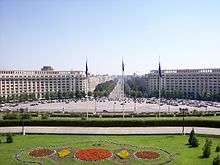Centrul Civic



Centrul Civic (Romanian: [ˈt͡ʃentrul ˈt͡ʃivik], the Civic Center) is a district in central Bucharest, Romania, which was completely rebuilt in the 1980s as part of the scheme of systematization under the dictator Nicolae Ceauşescu.
History
Bucharest suffered significant damage due to Allied bombing during World War II and the devastating earthquake of March 4, 1977. However, neither of these events changed the face of the city more than the Ceausescan "redevelopment schemes" of the 1980s, under which an overall area of eight square kilometers of the historic center of Bucharest were leveled, including monasteries, churches, synagogues, a hospital, and a noted Art Deco sports stadium. This also involved evicting 40,000 people after a single day's notice and relocating them to new homes, in order to make way for the grandiose Centrul Civic and the House of the Republic, now officially renamed as the Palace of Parliament.
Prior to starting to demolish the old historical town of Bucharest in order to build Centrul Civic, Bucharest (and other cities and towns throughout the country) had already suffered communist reconstruction, particularly in the 1970s, under the systematization programme which consisted of the demolition and reconstruction of existing villages, towns, and cities, in whole or in part, in order to make place to standardized blocks of flats (blocuri), after Ceauşescu got this idea during a 1971 visit in North Korea's which exposed him to Juche ideology. The construction of Centrul Civic and the demolitions necessary for it, however, were quite extreme even compared to other reconstruction communist programmes.
The vast empty fields which emerged in the historic town during the demolitions of the 1980s were sarcastically called "Ceaușima" (a portmanteau of Ceaușescu and Hiroshima). Concrete hulks of half-completed buildings (such as the new National Library of Romania) long stood where historic buildings (including most of the city's historic Jewish quarter) once stood. A remainder of the former "Ceaușima" is the never-completed eastern large area between the Mircea Vodǎ and Nerva Traian streets (some 30 hectares).
Centrul Civic is surrounded all-around by old historical buildings and neighborhoods (Lipscani street in particular is a famous old-fashioned street). Many churches, such as the Sf. Nicolai-Mihai Vodă Church, were moved rather than demolished, and the nearby Antim Monastery remains largely intact, although lacking its original eastern wing. Immediately next to the Centrul Civic, just off Unirii Square, is Dealul Mitropoliei, (the Metropolitan Hill), with the Patriarchal Cathedral and Palace, which is the seat of the Patriarch of the Romanian Orthodox Church.
Description
Centrul Civic is a complex of modern concrete buildings with marble façades, centered on a boulevard originally meant to be "the Boulevard of the Victory of Socialism". Being renamed after the Romanian Revolution of 1989 the Union ("Unirii") Boulevard, it has been modeled after Paris's Champs-Élysées, though a little wider; it runs roughly east-west, making a grand approach to the Palace of Parliament at its western terminus. A large balcony in the Palace surveys the entire length of the boulevard.
Centrul Civic includes numerous government offices and apartments, the latter roughly equalling the housing units destroyed for its construction. The apartments were originally intended to house Romania's communist elite, but the present final complex is certainly not a preferred residence for the city's new capitalist elite, with the possible exception of buildings that look out on the now-bustling Unirii Square. On this location the Centrul Civic bisects the Dâmboviţa River, which is channelled at this point underground the Square.
Centrul Civic stands out as a Socialist-Realism style monument with its architectural uniformity, but also because of its lack of commercial spaces. Most of the small shops and restaurants that form the heart of Bucharest are to be found in the areas immediately to the north of Centrul Civic.
References
| Wikimedia Commons has media related to Centrul Civic, Bucharest. |
Coordinates: 44°25′37.65″N 26°5′41.90″E / 44.4271250°N 26.0949722°E
